What is a media relations strategy?
By definition, a media relations strategy is the calculated deployment of media to tell an organization’s story. It is the process of figuring out a message and distributing it to the right media sources so that you can reach your target market.
Think of it as a fancier word for PR or press outreach strategy.
Media relations strategy has changed a lot in the last decade.
For one, the scope of “media” is a lot broader than it used to be. You don’t just have press outlets and TV stations under this term. You also have freelance journalists, bloggers, influencers, and anyone or anything with an audience.
You can even say that “media relations” today means “influencer relations”.
This new landscape also means that anyone can manage their own media relations strategy. You don’t have to go through gatekeepers and PR agencies anymore; you can connect with influencers directly.
How?
In this piece I’ll share 11 media relations tactics. Use them with the takeaways from my earlier post on marketing communications strategy to get press, backlinks, and mentions in the leading publications in your industry.
1. Write guest articles on targeted publications
I know what you’re thinking: Guest blogging? Seriously?
Now the death of guest blogging has been foretold many times. Most famously when Matt Cutts of Google asked everyone to “stick a fork” in it.
It is true that guest blogging purely for getting backlinks is spammy and a waste of time. But guest blogging for influence and traffic should still be a part of your media relations strategy.
The backlinks are just an added bonus.
For example, last year I wrote a guest post on the Moz blog that generated 140 comments from a hyper-targeted audience.

Guest blogging on targeted publications helps you piggyback on their effort. Instead of building an audience from scratch, you borrow theirs.
You also get access to their search engine authority. If you use the right keywords, your guest article can rank for valuable search terms, giving you traffic and visibility for years.
In fact, the #2 article for “guest blogging” itself is a guest post on Neil Patel’s blog
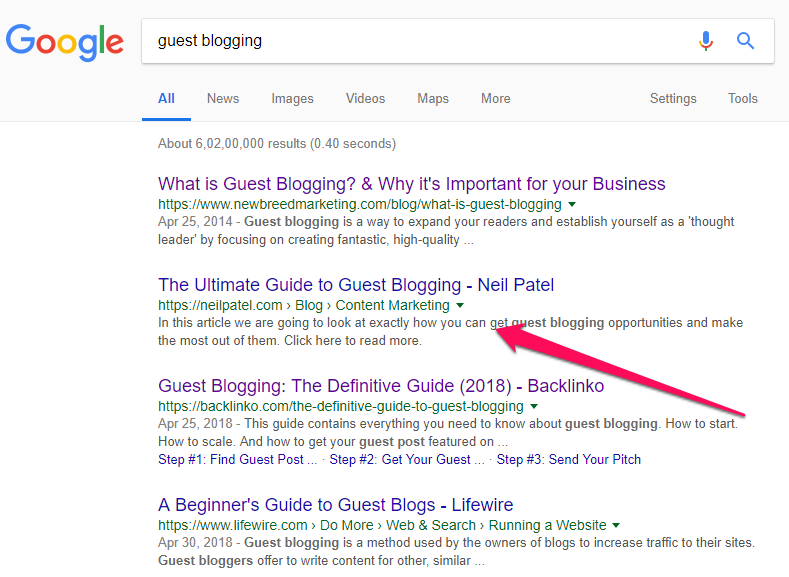
Essentially, guest blogging enables you to reach an audience outside your network. You get access to hyper-targeted readers hungry for expertise. It has countless benefits apart from backlinks:
- It builds your reputation; getting published on a top blog is a testament to your quality
- You can link to a targeted asset in your author CTA and capture high-quality leads
- Since top publications often have high authority, your guest posts can rank for major keywords and bring you long-term traffic
- Guest blogging is repeatable. If you can publish one guest post, you can also publish a hundred.
I should know, I’ve published 1,400 articles and counting, plenty of which were guest contributions.
The key to successful guest blogging is picking the right publication. Don’t simply go by a website’s domain authority or traffic.
Rather, look for outlets that have engaged and targeted audiences.
- Their content should be similar to yours and should demonstrate engaged readers.
- Check the average number of comments each post generates. Leaving comments on articles is a dying practice, so don’t expect 100+ comments for every post. Even a handful of comments (10+) can indicate engagement.
- Check if they’ve published guest posts in the past. If yes, how frequently do they publish guest posts vs their own editorial content?
- If it’s a popular blog, search for them on Facebook Audience Insights. See if their audience demographics and interests line up with yours.
Once you’ve found an outlet, approach them with your idea. If you can’t find an editor or their email address, look for past contributors. Email and ask them who is the right person to contact for a guest post on the outlet.
Ideally, your idea should align with the publication’s audience interests. It should also fill a gap in their content. For instance, if they don’t have content for an important keyword, they’ll be more likely to entertain a pitch for it.
When creating your guest post, focus on the following:
- Use Quora and Reddit to find questions and issues your audience actually struggles with.
- Try to write the best possible version of any content on your chosen topic. Not only is this great for getting published on prestige outlets, it also establishes your brand.
- Use visuals, infographics, videos, etc. to add value to your content.
Brian Dean has a detailed guide on guest blogging. For help with pitching your guest articles for your media relations strategy, refer to this article on JRO on PR outreach.

Another tactic to make your pitches more attractive is to align them to developing trends in your industry.
The best way to spot these trends is to see what top journalists in your industry are writing about. Just search for your keyword on JRO to see a list of target journalists and their recent articles. If you can somehow use these trends in your pitch while still creating evergreen content, your pitches will rarely be rejected.
2. Rank for topics people frequently write about
Imagine that you’re a blogger writing an article about managing a sales team.
Since you have zero knowledge about this topic, you Google “sales management”.
The first result you see is an article from Pipedrive.
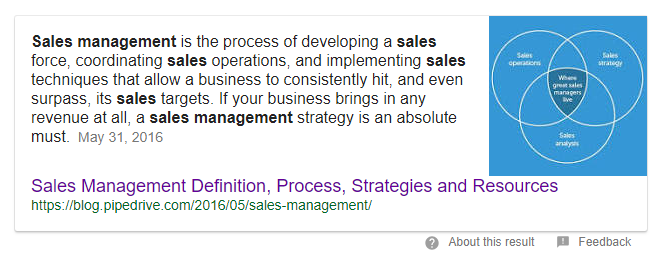
You read the article, gather your takeaways, and mention it in your post.
Pipedrive didn’t have to do anything to earn this exposure. Since it was already ranking for this keyword, the company can sit back and watch the links roll in every month from other blogs writing on the topic.
For example, if you look at Ahrefs data for this page, you’ll find that it has attracted a steady stream of backlinks since it was published, even though there has been no active link building for it (since it already ranks #1).
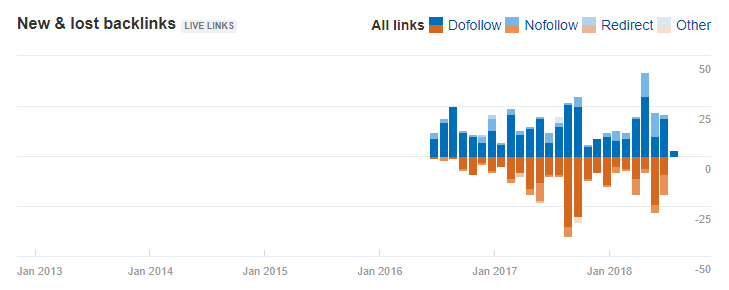
Much of these links are ‘passive’, i.e. they are from writers searching for “sales management”, and linking to the page, such as this one from Process.st.

Attracting such ‘passive’ links is an often-ignored media relations strategy. It has the dual benefit getting you links while also helping you rank for a key term.
Here’s how this tactic works:
- Find a topic that writers in your niche frequently write about, or need references for. Usually, these are statistics, studies, and other valuable content that supports their assertions.
- Create a comprehensive, in-depth content piece on this topic.
- Build backlinks to this content and get it to rank on the first page for a target keyword.
You’ll find that once you rank well for such topics, you’ll naturally attract additional backlinks from bloggers, writers, and other content creators looking for sources for their articles.
For example, bloggers frequently search for statistics to support their arguments. Top ranking pages for statistics, such as this one from CMI(which ranks for “content marketing statistics”), frequently gather hundreds of mentions from bloggers linking to them.

Here’s an example of Jeff Bullas linking to this page as a source for statistics:

Think of topics that people like to write about in your niche, or topics that require outside validation through surveys and statistics, such as:
- Roundup of statistics
- “Definitive’ guides
- Roundup of academic studies
- Controversial opinions and studies
- “Comprehensive” lists
If you can rank for these topics, you’ll find that links and mentions trickle in automatically.
The best way to create content for such topics is to follow the Skyscraper Method.
Popularized by Brian Dean of Backlinko, this tactic involves creating an authoritative article on a topic, then building targeted backlinks to it.
I used this tactic to help Pipedrive rank for the keyword I mentioned earlier – “sales management”.
You can read more about my ranking process in this case study. Learn more about the Skyscraper technique in this article.
3. Use Quora answers to kickstart relationships
A journalist at a top-tier publication receives hundreds of pitches every week. In fact, only 1% of top-tier publications in Fractl’s survey said that they find pitches “valuable”.
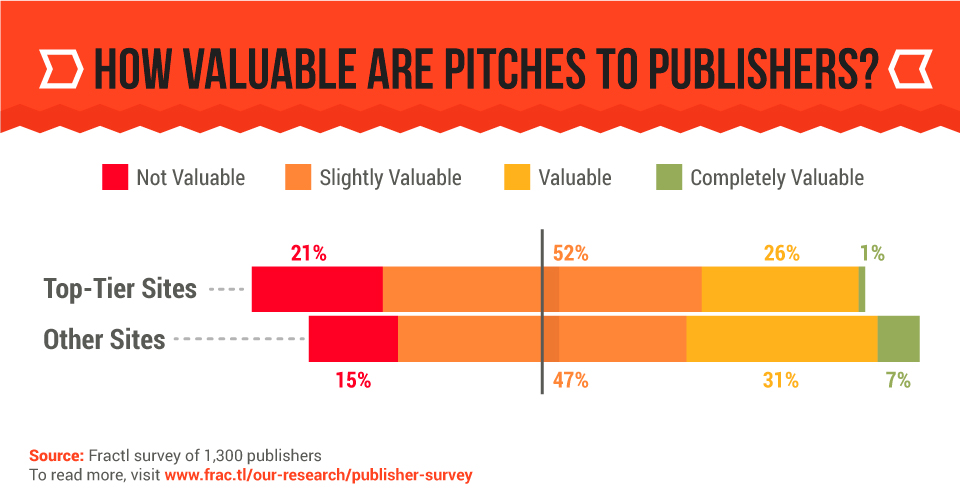
There is something cold and impersonal about pitching a journalist. Why should a TechCrunch or ReCode writer care about what you have to say if you’ve never taken the time to talk to them first?
This is why I’ve maintained that building relationships is the foundation of any competent media relations strategy.
When you have a relationship with a journalists, you aren’t just an unknown face from an unknown company. You’re a friend, a fan, and a potential collaborator.
At the very least, it ensures that your message will be read.
The problem is that building relationships is hard. You can easily come across as inauthentic and insincere.
One way to solve this issue is to piggyback on Quora.
Here’s how it works:
Find a journalist at a top-tier publication who you want to connect with.
Dig through their social profiles. See what they’re blogging, tweeting, and Snapping about. Your goal should be to find something that’s common between you.
My “sniff test” is that it should be something I can say to them in-person at a conference and not feel stupid about it.
Once you’ve found this thing, quote them in an article on your own blog. Defer to them as the authority on the topic.
For example, I wanted to build a relationship with Rebecca Grant, a former journalist at Venture Beat. So I found her blog and used a quote from one of her posts in my article.
Now here comes the Quora hack: after you mention the journalist in your article, search for the article topic on Quora. Find a question that has very few or no answers.
Write an answer to this question, making sure to:
- Link to your blog post related to the question
- Quote your target journalist in the answer
Here’s my answer to a PR question as an example:
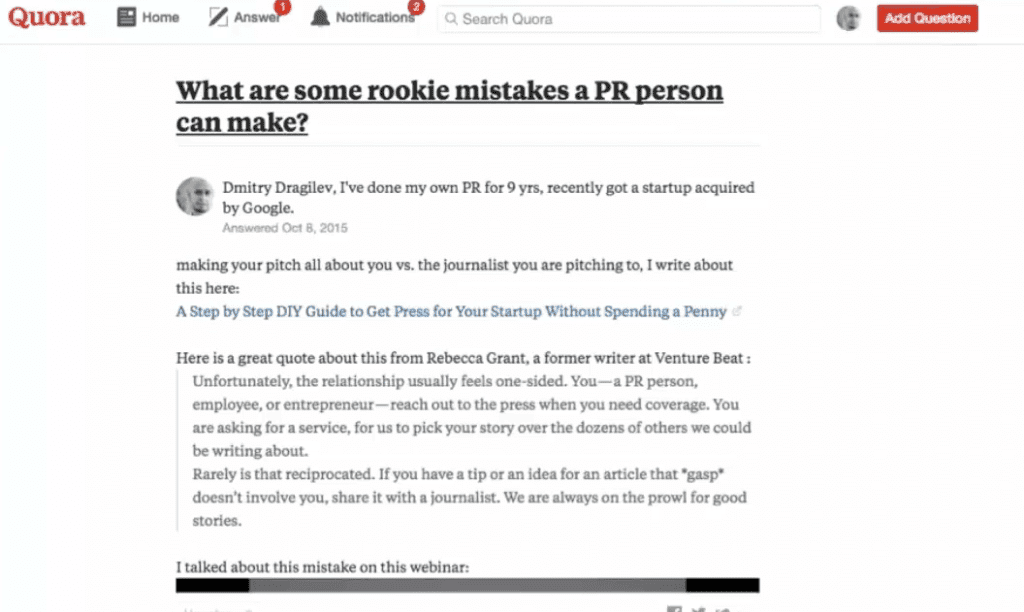
When you do this, you’re essentially promoting the journalist on a platform you don’t own for free. You aren’t just trying to selfishly promote your own content; you’re painting them as an authority on the subject.
This wins you a lot of brownie points with your target influencer.
Once you’ve done this, just shoot the influencer an email. Tell them that you mentioned them on Quora because you love their work.
For example, here’s the email I sent Rebecca:
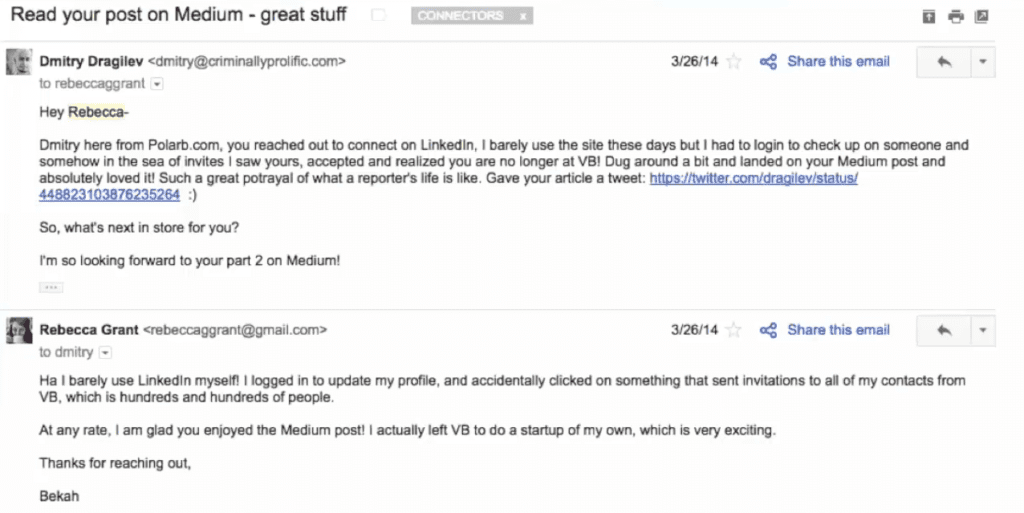
It might take time, but it essentially puts your relationship building on steroids – a key ingredient for a successful media relations strategy.
4. Answer press opportunities on HARO
What if I told you that you could get mentions in leading publications without chasing journalists?
What if I also told you that doing this was entirely free and required just 10 minutes of your time?
How?
Through HARO.
HARO, or Help A Reporter Out, is a service that connects journalists with sources.
Every day, HARO sends out two emails – morning and evening editions – with a list of journalists looking for quotes for their stories. There is a master email with all the queries, and further category-wise lists. You can decide which emails you want when you sign-up.

If you match the requirements of a query, you can simply shoot them an email with your quote.
For example, if you were a career coach, you could respond to this query and land a feature on Fast Company:
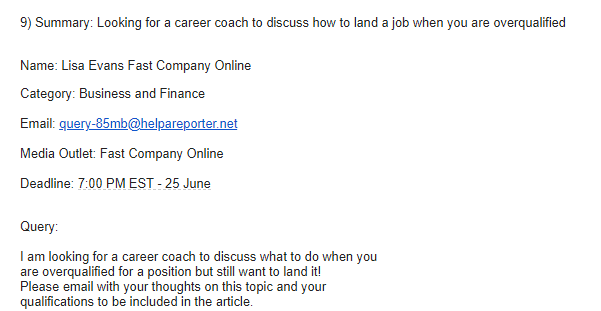
All the answers you send through HARO are collected in your HARO profile.
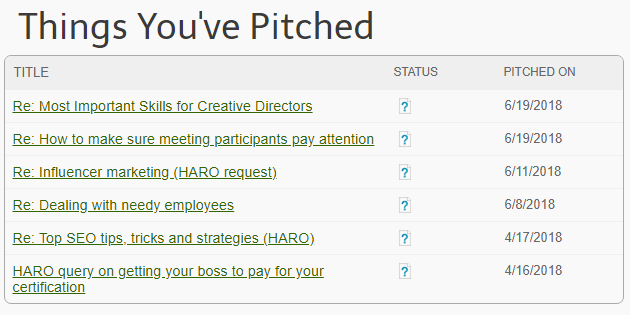
If you work in the business/finance or high-tech fields, you can usually find dozens of suitable queries every week. Answering them usually takes under 10 minutes – not a bad return for a feature in a top publication.
You can make this process even easier by using a tool like JustReachOut. Instead of looking through hundreds of queries every day, use JRO’s search feature to dig through HARO emails for your keywords.
Once you find a query, you can respond to it without leaving JRO.
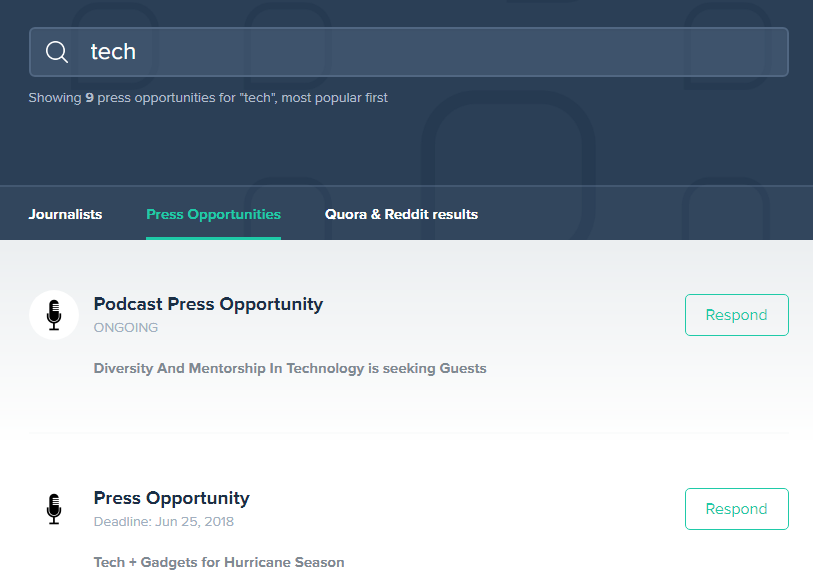

HARO is one of the most powerful sources of links and mentions, but it remains difficult to scale. You have to actively dig through long and text-heavy emails several times a day to spot opportunities.
A HARO search engine – like JustReachOut – makes it much easier to find and respond to press opportunities.
5. Target local TV stations and newspapers
In the hunt for the big feature on TechCrunch and Forbes, you can often miss the “low hanging fruit” of PR – local TV stations.
There are hundreds of local media websites spread across the country, and they’re all hungry for interesting news.
Because these websites don’t have the same visibility as the Buzzfeeds and Forbes of the world, they often fly under the radar of entrepreneurs.
Yet, targeting them in your media relations strategy can yield rich rewards, especially for the amount of effort you need.
Start your search by heading to USNPL. This website lists newspapers, TV stations, and radio stations in every city in the country. This is one of the most comprehensive listings you’ll find anywhere online, and it’s entirely free.
For example, here are all the major newspapers in San Francisco, along with their social media links:
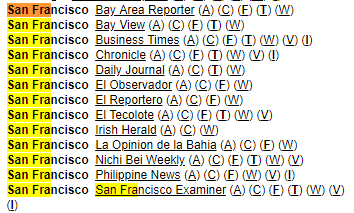
For local radio stations, use Radio Locator to find stations by zip code, along with their websites.
For example, here are all the radio stations that cover 90210.
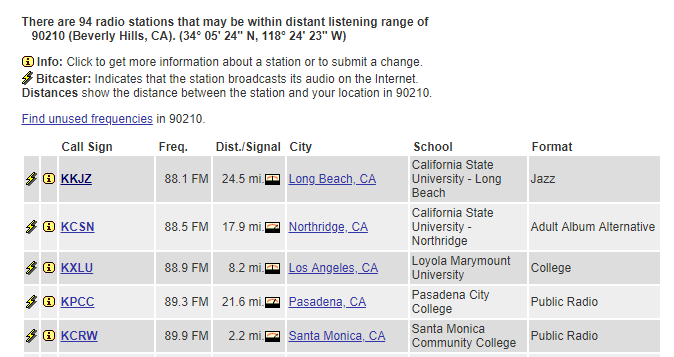
Once you’ve made a list of targets, the pitching process is the same as pitching any other journalist. Follow the guidelines in this article to learn how to pitch journalists.
Give local journalists a reason to cover your business. You don’t have to have a local presence, but it helps.
Otherwise, focus on the following:
- Newness, i.e. you’re just launching and giving the journalist exclusive early access.
- Popularity, i.e. you’re popular and you want to help the journalist – and their readers – understand why.
- Uniqueness, i.e. you’re doing something that is either unique to the neighborhood, or will solve their readers’ problems in a unique way.
For example, I used this tactic to get one of my clients, RoboKiller, featured on local TV station websites. I emphasized the uniqueness of the solution and how it helps anyone, including the station’s audience:
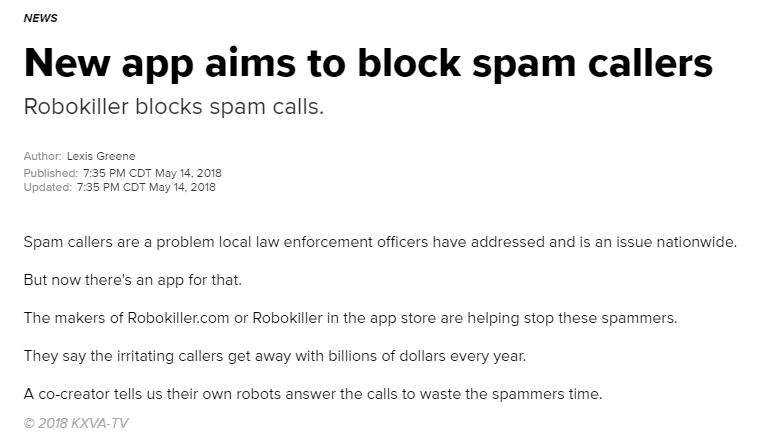
This is a powerful, yet underused tactic that can get you a lot of traction for free.
6. Create an asset that corrects or refutes a popular hypothesis
Which cars are most likely to last for over 200,000 miles without falling apart?
If you were a car enthusiast or were interested in a new car, wouldn’t you be interested in the answer to this question?
Turns out that journalists are also interested in such questions. Because that’s how iSeeCars’ study on the longest-lasting cars to reach 200,000 miles ended up with over 50 backlinks and mentions in major outlets such as FoxNews.com.

The idea behind this media relations strategy is simple: collect data that answers a popular question. Then create an asset that condenses that data into a shareable format. Distribute it to targeted publications and get free press mentions.
For example, lots of bloggers have wondered: what’s the ideal article length for SEO?
So Brian Dean commissioned a study to answer this question with data, earning hundreds of links in the process:
Your research doesn’t always have to be original. If you can synthesize complex data from multiple sources into something that’s easier to digest, you can get press mentions, regardless of your size.
For example, this blog used data from Forbes and BLS.gov to answer the question: how quickly do top musicians make average salaries? There is no original research; it’s just a synthesis of available data.

If you’re going to use this approach, think of what angles you can use to promote your study. Some common angles are:
- Giving a definitive answer to a common query (as in “how many words should a blog post have?”).
- Giving a new perspective to existing data (as in “how quickly does Beyonce make a nurse’s salary?”).
- Countering a widely held opinion or belief (as in “everything you knew about passwords is wrong”)

Since your ultimate goal is to get published in major press outlets, it helps to know what your target journalists have been writing about lately. The closer the alignment between your content and the journalist’s “beat”, the better your results.
This is why when you search for a keyword on JustReachOut, you will see the last articles written by the journalist. Use it to find journalists who would be more interested in your content.
7. Use reverse image search and Crunchbase to find press targets
One of the toughest tasks in any PR campaign isn’t pitching journalists or building relationships. Rather, it’s finding the right press targets.
Besides the usual – Google search, directory listings, etc. – there are a couple of underlooked tactics that yield some great results.
The first tactic is reverse image search.
Here’s how it works:
Head over to Pinterest and search for your target keyword, such as “content marketing”.
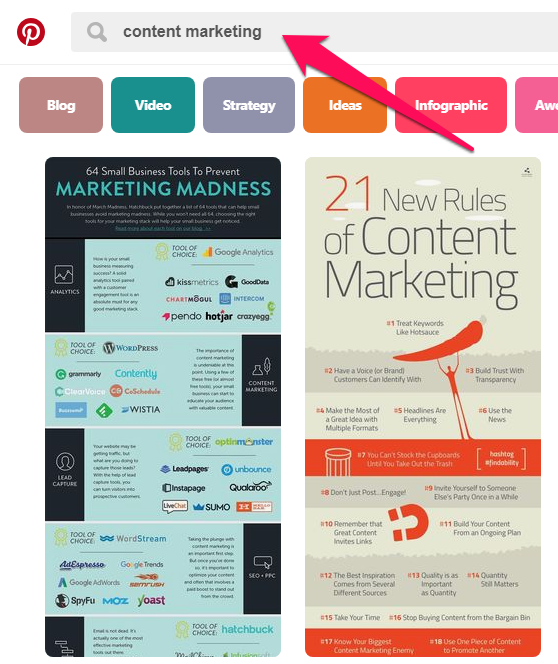
When you find a well-liked infographic or image, click to open it. Once opened, right click on it and select “Search Google for image”.
This will show you every publication that has published that image.
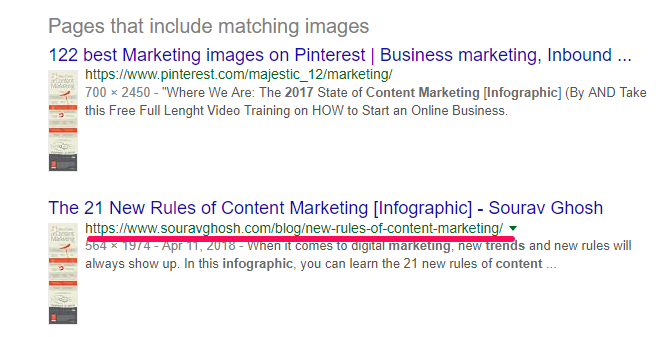
Make a list of all such publications. If they’ve shared similar images in the past, they might be interested in sharing your stuff a well.
Another little-known tactic is to use Crunchbase.
Crunchbase is a massive database of companies, their founders, funding, and all the press they’ve received lately.
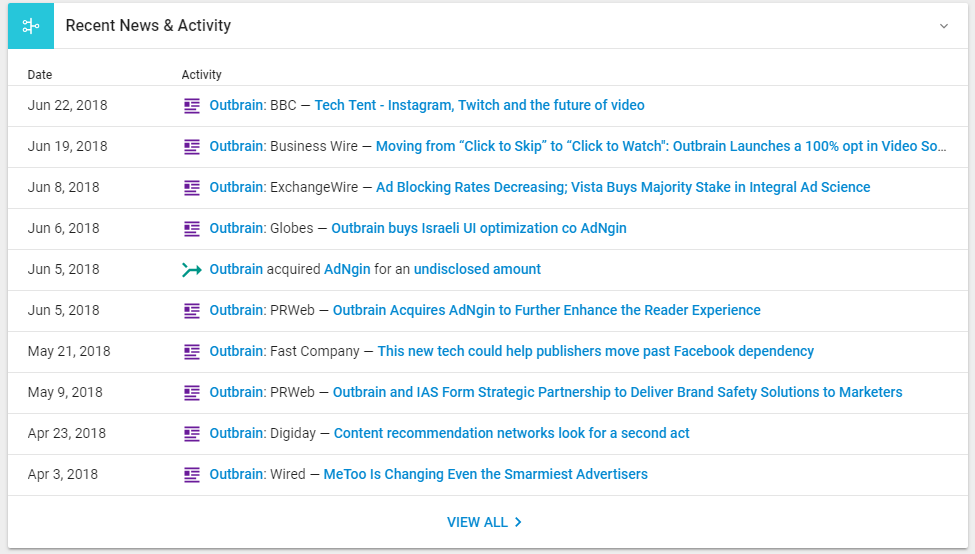
Start by heading over to Crunchbase and searching for a competitor. If you don’t have an immediate competitor in mind, you can also search for your industry keyword and pick from the companies that show up.
Once you find a company, scroll down to the “Recent News & Activity” section. This shows all the press the company has received lately.
Look for patterns and ideas – why are press outlets writing about this company? Is it because it released a new study? Launched a new product? Wrote an article?
Think of how you can replicate this by creating similar assets or studies.
8. Create a PR stunt
When it comes to PR stunts, opinion is usually divided. Some see it as a staple of marketing that yields spectacular results. Others see it as a cheap and gimmicky tactic that is more likely to annoy than attract customers.
The truth is somewhere in between. PR stunts can be gimmicky, but they can also be wildly effective.
The trick is to use them in the right quantity. Like seasoning, sprinkle them on top of your existing media relations strategy, instead of making them the mainstay of your approach.
To create a successful PR stunt, keep in mind that:
- The primary audience for a PR stunt is the media, not your customers
- That the PR stunt should be aligned with your brand
An outrageous and offensive stunt by a family-friendly company might get the press talking, but it can also damage the brand.
Start by evaluating routine press coverage about your industry. Ask yourself:
“What are some common angles journalists adopt when covering my competition? What can I do to set myself apart and capture their attention?”
Your goal should be to do something that is different from the norm. If all your competitors are focused on creating podcasts and digital assets, do the opposite and go local. If they’re doing edgy, offensive stunts, do something genuinely nice and charitable.
For example, lots of startups interview other business owners and host podcasts. But Gusto did something different – its founders went on a 3,000 mile road trip where they met and talked to actual small businesses.
Because this was so different from what the rest of the industry was doing, Gusto was able to get major press.
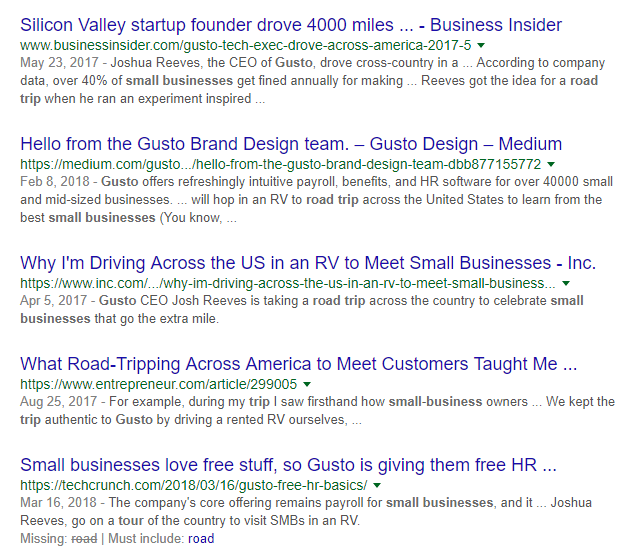
As far as PR stunts go, this one was fairly tame and easy to pull off. Yet, it attracted major attention from the press simply because of how unique it was for its industry.
Daney Parker of PRMoment has a great article on creating a PR stunt. Her advice: effective PR stunts are visual, clever, and reactive. But as Gusto showed, being useful and unique can also get you press.
9. Target small but influential publications
If you’re going to invest time and money into a PR campaign, it only makes sense to target the biggest publications out there, right?
Wrong!
This is one of the biggest rookie mistakes I see entrepreneurs making. They jump right in and start emailing Forbes and Buzzfeed, completely forgetting about the small but influential blogs.
You see, even top journalists need their sources. More often than not, these sources are smaller, niche-specific blogs.
For example, here’s TechCrunch with a “hat tip” to Android Beat:
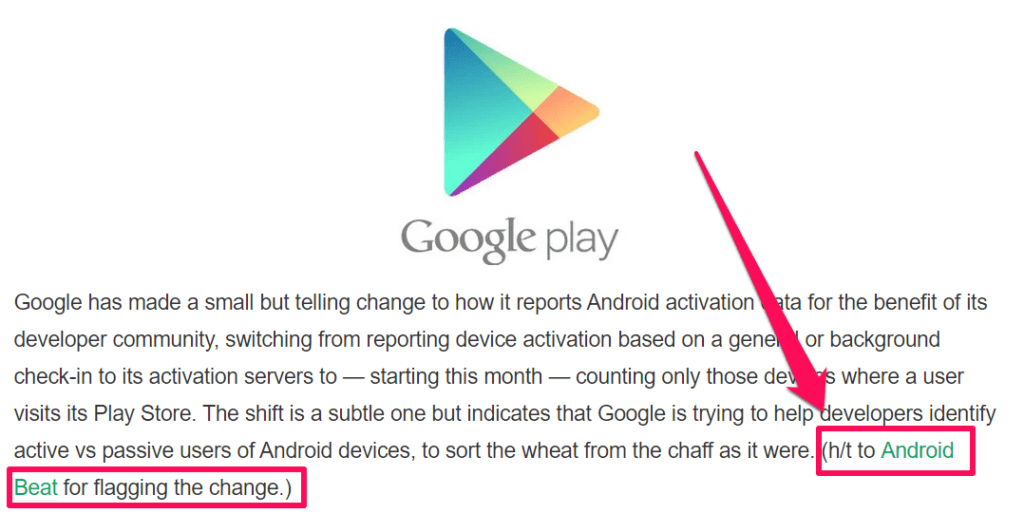
It’s much easier to get the attention of these smaller blogs than large publications. For one, these smaller outlets are often one-person operations. There are no editors and gatekeepers to go through.
Two, smaller outlets don’t get nearly the same number of pitches as a larger outlet. It’s easier to stand out when you aren’t competing with 100 peers.
If you do get a spot on these smaller outlets, you’ll often find that bigger publications will come your way as well.
One way to find these smaller outlets is to search for lists of blogs in your industry (Google “list of [industry]blogs”].
Find smaller blogs on this list that you don’t immediately recognize. Add them to your backlinks analyzer such as Ahrefs. See how many large publications link to them.
A smaller outlet that frequently gets links from bigger publications is likely influential. Getting on such an outlet can open doors to wider coverage, making them an indispensable part of any media relations strategy.
10. Launch on Kickstarter
Want to get the attention of major press outlets and get some extra funding?
Then launch your product on Kickstarter.
Kickstarter is like the milkshake that brings all the journalists to the yard. For some reason, adding this word to a news story automatically gets writers, and the people who read them, excited.
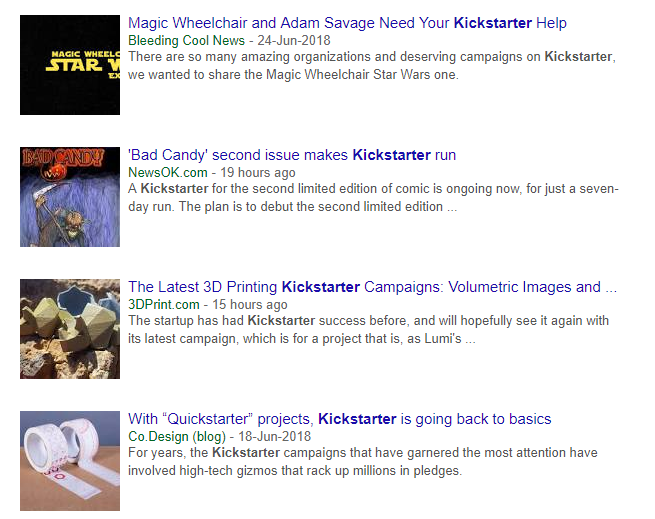
You can probably figure out why: Kickstarter products are novel and often controversial. From outrageous claims to missed goals, a Kickstarter usually makes for an interesting story.
Tap into this by launching your product on the platform.
Of course, this isn’t possible for every company. And some categories do attract more journalist attention than others (visual, tangible products, especially in tech/lifestyle categories).
But if it is possible, consider launching on Kickstarter/IndieGoGo to give your media relations strategy an early boost.

You’ll see much better results from any Kickstarter campaign if you invest a little time in building relationships with journalists. Journalists are far more likely to respond to you if they know and recognize your name.
Of course, if you don’t want to do that, there are also services such as JustReachOut that will do the pitching for you.
11. Interview influencers and get them to promote you
One of the most compelling ideas in marketing is branding by association.
Branding by association is when you create a linkage between two brands of unequal value. The interplay between the two brands increases the value of the lower-tier brand.
Think of how Nike thrived by associating itself with Michael Jordan. Jordan was already a star; Nike was still a (relatively) unknown brand. By getting Jordan to endorse it, Nike absorbed some of Jordan’s brand value.
The same principle is equally applicable when building your business brand. When you constantly appear next to influencers and thought leaders, some of their influence rubs off on you as well. People assume that since you’re appearing alongside Tim Ferriss and Rand Fishkin, you too must have some expertise.
Additionally, when influencers promote your content, you get a share of their traffic as well.
This brings me to the biggest challenge with this media relations strategy: getting access to top influencers.
It’s no secret that leading influencers are all incredibly busy. You can’t just email Tim Ferriss and ask to interview him if you’re a nobody.
The solution?
Influencer stacking.
Essentially, instead of targeting the big whales like Ferriss, you target low-tier influencers. Think of people who have some authority, but not enough to be inaccessible.
Once you land an interview or a roundup quote from them, refer to it to get access to higher-tier influencers.
Repeat the process until you reach the influencer you want to target.
This process helped me get quotes from people like Paul Scoble and Chris Messina:
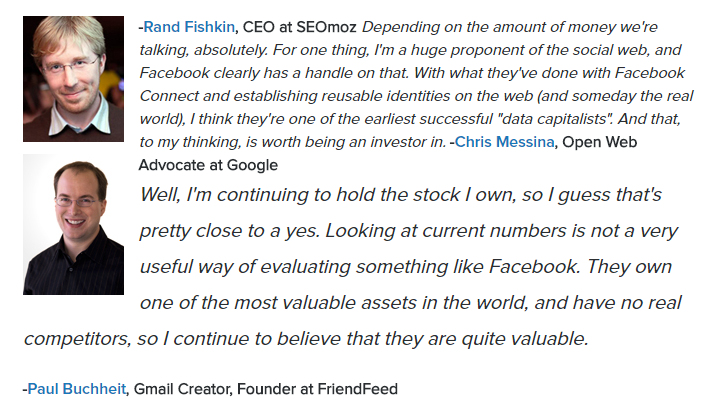
If you’re going to use this media relations strategy, make sure to change your content approach based on the influencer’s authority and availability. You can likely ask a low-tier influencer to appear on a 30-minute podcast or Skype video interview.
Busier influencers, however, won’t have enough time for a 30-minute appearance unless you’re already well-known yourself. Ask such influencers for quotes for a roundup instead.
Once you create your content, make sure to run some Facebook ads on it. Your goal is to drive traffic to the influencer’s site as a way to say “thanks” for their contribution.
If influencers see that the content is popular, they’re more likely to return the favor by promoting you.
Over to You
We’ve covered a lot of media relations tactics in this article. You don’t have to use all of them. Just pick a tactic that is easy to implement and can be repeated. Most importantly, once you pick a tactic, stick to it for at least a few months before trying a new one.
Get in touch with me for more help with creating a media relations strategy.
–
This article first appeared in www.criminallyprolific.com
Seeking to build and grow your brand using the force of consumer insight, strategic foresight, creative disruption and technology prowess? Talk to us at +9714 3867728 or mail: info@groupisd.com or visit www.groupisd.com




